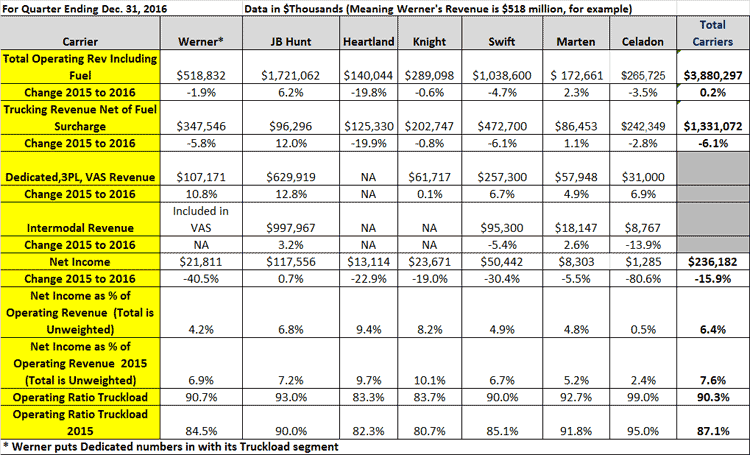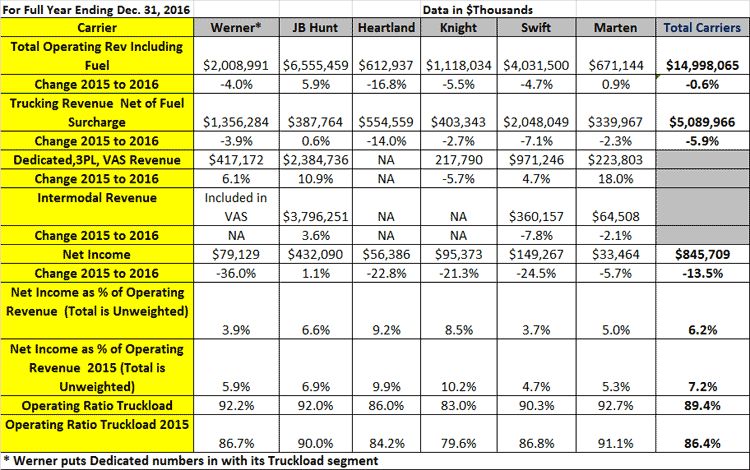It was yet another soft quarter for US truckload carriers in Q4, as nearly all of them cited weakness in volumes and rates, with profits profits for the group of seven carriers we follow down 15.9% year over year, putting a generally disappointing end to a weak overall year in 2016.
That result from what most described as a very soft freight environment, with rates generally down from low to mid-single digits, though some signs that is turning around.
Supply Chain Digest Says... |
 |
| Average operating ratios rose sharply in Q4, from 87.1% on average for the group in Q4 2015 to 90.3% in this latest period |
 |
What do you say? |
| Click here to send us your comments |
 |
| Click here to see reader feedback |
|
|
From an overall market perspective, the Cass Linehaul Index, which measures US truckload rates before accessorials, fuel surcharges and other fees, was down all three months of Q4, falling 1.4%, 1.5% and 0.9% year over year in October, November and December, respectively.
That made it 10 consecutive months of year over year declines in rates, with only January and February seeing modest increases in the year.
Werner noted that "2016 was a very challenging freight and rate year for our truckload and logistics business segments."
Werner also said it often chose to walk away from some customers wanting rate decreases in the mid-single digit range earlier in 2016, but that "In fourth quarter 2016, transactional spot rates demonstrated material improvement, and contract rates began to stabilize for new contracts."
JB Hunt said in Q4 its truckload segment revenue decreased 3%, primarily from customer rate per mile decreases of approximately 1.4%.
Meanwhile, Swift said "The fourth quarter capped a very challenging 2016, as rising fuel prices and a weak used truck market compounded the negative impact of the pricing and freight volume headwinds prevalent within the market."
But Werner's somewhat positive take on current conditions for carriers was echoed by Knight Transportation, which said in its earnings releases that "The freight environment continues to show signs of improvement as we experienced more non-contract opportunities during the fourth quarter of 2016 when compared to the same quarter last year."
All of the carriers we follow were again profitable in Q4 even in the soft environment, with net margins (net income as a percent of revenues) ranging from 9.4% at Heartland Express to just 0.5% at Celadon, which made it back into our group after some financial reporting issues last year made its earnings releases very late.
In aggregate, profit margins fell across all seven carriers from 7.6% in Q4 2015 to 6.4% this year in our unweighted average.
Average operating ratios, or operating expense divided by operating revenue, a key transport sector metric, rose sharply in Q4, from 87.1% on average for the group in Q4 2015 to 90.3% in this latest period.
The full table of results from our carrier group is provided below:
Q4 2016 US Truckload Carrier Results

Source: SCDigest Analysis from Company Earnings Releases
It was much the same story for the full year results, with net income down with net income down 13.5%, and operating rations rising from 86.4% in 2015 to 89.4% for all of 2016.
Note Celadon is excluded from the full year results because it operates on a different fiscal calendar.
Full Year 2016 US Truckload Carrier Results

Source: SCDigest Analysis from Company Earnings Releases
(See More Below)
|
CATEGORY SPONSOR: SOFTEON |
|
|
| |
|
|
Highlights of the comments from each carrier in their earnings releases are provided below, starting with Werner, which as usual provided the most in-depth commentary. As you will see, there was a bit of a trend in terms of reducing truck counts or moving trucks from common carriage to dedicated service, but these moves were generally modest.
Concerns about the driver shortage were still there, but clearly more muted than in recent periods.
Werner
Said that "2016 was a very challenging freight and rate year for our truckload and logistics business segments."
Company moved 150 trucks from one-way truckload to its dedicated business, lessening the need to find satisfactory freight for the trucks in the more challenged one-way truckload market, after having moved 100 trucks to dedicated in Q3.
Freight volumes and transactional spot market pricing in the one-way truckload market improved in fourth quarter 2016 versus 2015.
Werner noted that earlier in the year, it chose to exit from certain contractual business that would have required mid-to-high single digit contractual rate decreases for the next year, "since we believed that this pricing was not sustainable."
It said that "In fourth quarter 2016, transactional spot rates demonstrated material improvement, and contract rates began to stabilize for new contracts. Expectations are rising for improved pricing in 2017, noting a more positive economic outlook, rationalizing industry truck supply, normalized current customer inventory levels and the much anticipated supply-constricting December 2017 electronic logging device (ELD) regulatory mandate."
Werner averaged 7,178 trucks in service in its truckload segment, ending 2016 with 7,100 trucks, a year-over-year decrease of 350 trucks.
Net capital expenditures in 2016 were $429.6 million compared to $351.5 million in 2015.
Werner said that for the first 30 days of January 2017, the average diesel fuel price per gallon was 63 cents higher than the average diesel fuel price per gallon in the same period of 2016 and 54 cents higher than in first quarter 2016.
JB Hunt
Load growth of 5% in intermodal was the primary reason for a 3% increase in segment revenue.
Dedicated contract services segment revenue increased by 8%, primarily from the addition of new customer accounts, rate increases implemented in the current and earlier periods and improved asset utilization.
Said its truckload segment revenue decreased 3% primarily from customer rate per mile decreases of approximately 1.4%.
At the end of the period, Hunt operated 2,128 tractors compared to 2,149 a year ago in its truckload segment.
Heartland
Said Q4 and full year 2016 results were achieved "even though our top-line revenue was challenged by significant pricing pressure from shippers attempting to capitalize on short-term excess capacity in the industry."
The average age of the Company's tractor fleet was 1.7 years as of December 31, 2016 compared to 1.25 years at the end of 2015.
Knight Transportation
Company said "The freight environment continues to show signs of improvement as we experienced more non-contract opportunities during the fourth quarter of 2016 when compared to the same quarter last year."
Knight noted that "With declining new truck orders, a weak used equipment market, and additional regulatory burdens expected to phase in during 2017, we expect continued improvement in the supply/demand relationship in the coming quarters."
The average age of Knight's tractor fleet is 2.2 years, which has increased from 1.8 years from the second quarter of 2016. This is because "With rising new equipment prices and a weak used equipment market, we have extended the expected trade cycle of our tractors."
Noted that "Driver pay continues to be inflationary when compared to the same quarter last year."
Swift
Company said "The fourth quarter capped a very challenging 2016, as rising fuel prices and a weak used truck market compounded the negative impact of the pricing and freight volume headwinds prevalent within the market."
Added that "Excess carrier capacity and pricing pressure continue to challenge the marketplace."
Due to the weak market, Swift reduced its truck count in Q4 by 746 versus 2015 and 210 over Q3. However, the company's dedicated segment saw its truck count grow by 86 units.
Marten
Company noted that "Despite persistent softness in the freight market, which has challenged our truckload segment, we have continued to demonstrate the strength of our unique multifaceted business model by achieving our eighth consecutive year-over-year increase in quarterly operating income within each of our dedicated, intermodal and brokerage segments."
Marten increased its average number of truckload and dedicated tractors by 226 tractors, or 9.1%, in 2016 over 2015 with the expansion of its dedicated fleet operations.
Known of course for its refrigerated transport services, Marten said it is expanding its dry freight services, with 921 dry trailers operating as of the end of the year.
Celadon
Company said "Our more specialized businesses, such as short-haul regional, bulk, and dedicated, produced solid profitability during the quarter. However, our irregular route, dry van trucking business experienced an operating loss due to weak demand, rate pressure from customers, and increasing costs."
Company continues to downsize its fleet. There was a decrease of 540 in seated truck count compared to the December 2015 quarter (decrease of 249 company trucks and 291 owner operators), primarily due to a planned downsizing of its fleet based on weak freight demand.
The company expects in the March quarter to be down approximately 200 additional trucks from December quarter's average with further decisions about fleet size to be made as the year develops.
Any reaction to the Q4 review of the truckload sector? Are you seeing falling ratese, or are they headed back up? Let us know your thoughts at the Feedback section below.
Your Comments/Feedback
|